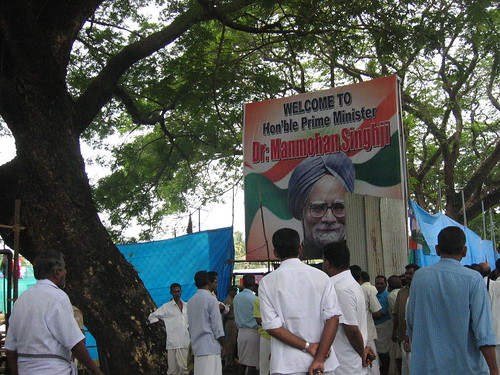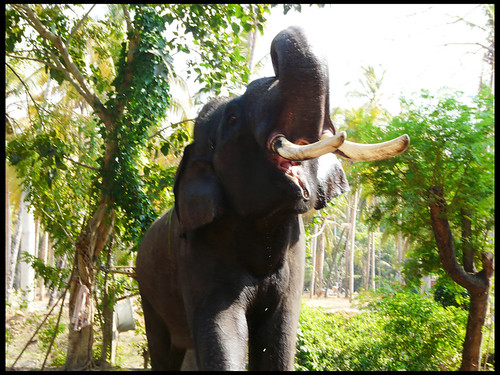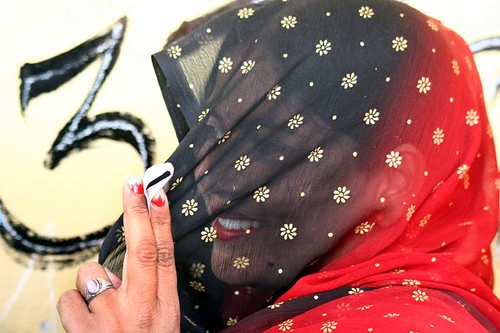
Queue at an ATM for money in Howrah, West Bengal, on 8 November 2016
Since Indian Prime Minister Narendra Modi declared Rs 500 and Rs 1,000 notes invalid on Tuesday in a sudden and unexpected move for demonetisation of high value banknotes and replacing them with newly printed notes of denominations Rs 500 and Rs 2,000, he has got a mixed bag of reactions. Some are hailing the move while some others are severely criticizing it. How some of the politicians reacted to the move are below.
Indian National Congress criticised the central government's move to ban Rs 500 and Rs 1,000 notes. Congress Vice President Rahul Gandhi said that it shows how little Narendra Modi cares about ordinary people. On November 11 Gandhi stood in queue outside the State Bank of India on Parliament Street in New Delhi to experience the ‘pain of the people’. He talked to some people to know their troubles. He said to news reporters who interviewed him, “Poor people are in trouble, I am here to get Rs 4, 000 exchanged. Neither you (the reporters) nor your crorepati owners nor the Prime Minister will understand the problems faced by people.”
Punjab Pradesh Congress Committee (PPCC) president Captain Amarinder Singh on Wednesday criticised the manner in which the government handled demonetisation. Singh said, “Though the move was a step in the right direction in order to curb corruption, terror funding and black marketing, the way it had been handled had led to chaos, with the small farmers, traders, daily wagers and the poor the worst hit.”
West Bengal Chief Minister and the chief of Trinamool Congress Mamata Banerjee tweeted, "I want to know from the PM how my poorest brothers, sisters who've received their week's hard earned wage in one Rs 500 note will buy atta, chawal, tomorrow?" She told the press in Kolkata on Saturday that despite ideological differences she is ready to work with CPI (M), Congress, Samajwadi Party, and Bahujan Samaj Party ‘to save the country’.
Delhi Chief Minister Arvind Kejriwal (AAP) alleged, "Demonetisation is a big scam... People close to BJP were alerted in advance. There were heavy deposits in banks in July-September quarter. Who deposited these thousands of crores suddenly?"
Mulayam Singh Yadav, the chief of Samajwadi Party (SP) that rules Uttar Pradesh, said on Thursday at a press conference in Lucknow, “The sudden ban on high denomination notes has caused immense hardships to commoners, farmers and the poor, the demonetisation has been done by the NDA government with an eye on elections, and not keeping plight of people in mind.” He further said, “We are against black money. SP has fought against it. We do not want use of black money in elections.” He demanded a rollback of the ban ‘for a few days in view of the wedding season’.
Uttar Pradesh Chief Minister Akhilesh Yadav (SP) asked the government to ‘take all possible steps to minimise inconvenience to common people’, adding, "Central government must set up special banking counters in villages and district centres to assist the public, villagers and farmers."
Bahujan Samaj Party (BSP) chief Mayawati told reporters in Lucknow, “Economic emergency like situations have been created by the government to hide their inefficiency. Poor people, middle class citizens, small businesses and farmers have been hit the most and not the people who have black money.”
The Communist Party of India (Marxist), CPI (M), on Wednesday alleged that the move will burden ordinary people and increase bureaucratic harassment of people. Sitaram Yechury, the CPI (M) General Secretary, described it as ‘poorly planned’. He tweeted, "To uncover the illicit money trail, we demand that the govt release the name of Top 100 defaulters of bank loans". "This demonetisation is attempted as a gimmick to divert attention from serious social and political failures of this govt in past 2.5 years."
Pinarayi Vijayan, Chief Minister of Kerala - ruled by the CPI (M)-led Left Democratic Front (LDF) - criticized the demonetisation saying, “It has to be understood that those who are having black money were aware of this earlier and hence they have not been affected with this. It has only affected the common man the most. The Centre has implemented this without looking into the practical difficulties face by the people." He wanted time till December 31 for people to use the existing notes.
Goa Chief Minister Laxmikant Parsekar (BJP) told reporters on Wednesday the demonetisation would not affect tourists who had arrived in the state. He said, “Like other people, the tourists can convert up to Rs 4,000, and usually they avail the facilities using credit cards. The inconvenience will be only for a day. From day after tomorrow, they can withdraw from ATMs”. He said he was personally happy with the ban which was to curb corruption, black money and terrorism. “There are some politicians who have stashed black money in their go downs. They are now having the sleepless nights,” he said, further adding that the clampdown on black money will also ensure that there is a ‘cleaner pre-election period’”.
Andhra Pradesh Chief Minister and the Telugu Desam Party (TDP) chief N Chandrababu Naidu described it as bold step. However, he suggested that reintroduction of high denomination notes should be revisited and urged the government to look for alternatives.
Swaraj Abhiyan leader Yogendra Yadav tweeted, "Positive move against counterfeit currency. Govt overplaying impact on black money. Opposition overplaying transitional problems."
It appears that demonetisation was initially welcomed by the people and political parties in India, with a few exceptions. But it is usually alleged that black money is used by politicians to influence voters during elections. State Assembly elections are going to be held in UP, Punjab, Goa, Uttarakhand and Manipur early next year. So, experts see a political angle in the move. However, the negative reaction to the government’s order, claiming to curb black money and counterfeit banknotes, is not as much as it should be for such a drastic move.
As a result of demonetisation, most people ran short of cash, and there was no way to exchange the higher value notes. Neighbourhood shop keepers and other traders refused to accept the banned notes. Banks were closed immediately after the currency ban to replenish their old currency stocks with the newly printed series of 500 and 2000 rupee notes.
According to political analysts, its impact is expected to show up in the assembly election outcomes in the five states of Punjab, Goa, Uttarakhand, Uttar Pradesh, and Manipur to be held early next year.



